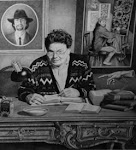Over a month passed before the next communication from
Bishop to Grace — at least the postcard that was sent on 6 March 1916 is the
one that survives. It is not possible to know if Bishop had written in the
interim (since the 30 January letter), but perhaps not because as the following
postcard, dated 27 April (again, a significant gap), shows, the quiet life at
Samambaia had given way to long stretches in busy Rio.
The March postcard was typed and was by way of acknowledging
a “nice letter” from Grace. With very little room, Bishop offered a quick
update, reporting that “Monica is a darling baby … so good and laughs
all the time.” She declared that Mary was lucky to have such a child. Then she
described the verso of the postcard: “the house where we stay in Ouro Preto.”
This house belonged to their friend Lilli
Correia de Araújo and was called Pouso Chico Rei. She noted that it “is run as
a small hotel … room for 8 people.” Bishop wrote that she wanted the
Naudins to “go there — in fact they must!” But even more than that,
Bishop wanted Grace to visit her and see this historic city: “Oh dear — I wish
you were coming here instead — or too, I shd. say!” hinting that the dynamics
with her cousin remained fraught.
(The image on EB's postcard of Lilli's hotel)
Bishop urged her aunt “to find out about the boat fares and
let’s see.” Bishop promised that she would look into “freighter fares” (a
preferred way for Bishop to travel), but she recognized that such a mode of
transportation might be an issue for her elderly aunt because “they are apt to
take forever.” But, then, perhaps Grace wouldn’t mind “18-25 days at sea.”
Bishop commiserated over airplanes “(I loathe flying, too, even if I do it once
in a while.)” And acknowledged that ship travel was “more expensive than
tourist-planes now.”
(Pouso Chico Rei still operates. I know a couple of people who have stayed there in recent years, and am told there is an EB room!)
The card was nearly full so Bishop quickly added the old
news: “I got a grant a while ago” (the Chapelbrook Foundation Fellowship),
which required her “to go travelling on it this year.” A little scribble on the
front of the postcard was it for this brief missive.
If Bishop responded to Grace’s March letter, it does not
survive. Her next note to Grace is another postcard, this one hand-written,
dated 27 April. It was written in Rio, where
Bishop said they now spent “3 or 4 days every week … because of Lota’s job.”
Being more in Rio meant that she was able to
see her cousin more: “I saw E and Suzanne yesterday,” perhaps to give a
birthday present to the child who had turned five on 12 April. It appears
Bishop had not heard recently from her aunt, but said that her cousin “said
she’d heard from you — I hope that means you are lots better & up &
about.” Bishop had clearly heard something of this most recent trouble, though
just what was wrong with Grace is not stated.
The verso of this postcard showed a bird’s eye view of the Rio waterfront, expansive enough for Bishop to be able to
show where she and Lota were in relation to the Naudins. Bishop marked
north-south-east-west on the image and put an X where she lived and where the
Naudins lived. Bishop was ever making maps!
Bishop still had not given up hope that Grace would visit,
as she concluded this scribble message by saying, “If you came you could stay
here if you wanted.” She signed off by saying that she hoped to “hear from you
soon — Love, Elizabeth.”
The next communication from Bishop, dated 20 June 1961, is a
full-blow letter, which will be the subject of the next post.








No comments:
Post a Comment